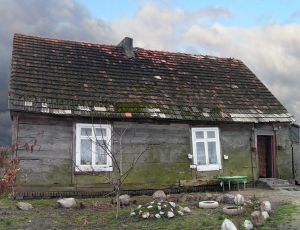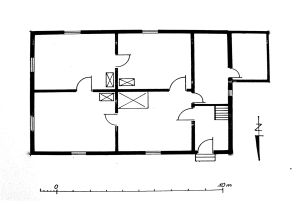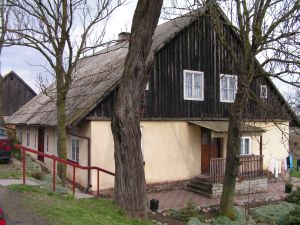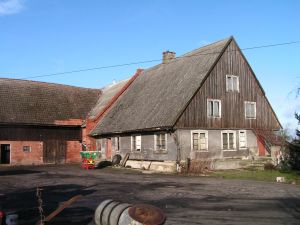|
gm. Dragacz, pow. ¶wiecki, woj. kujawsko-pomorskie

The first mention of the village dates from 1307, when knight Żywan donated the settlement to Pelplin Cistercians. In 1423 in the village there was a manor belonging to the ¦wiecie komturia. In the second half of the 16th century the settlement is listed among the royal properties in the Pomorskie Voivodeship, ¦wiecie poviat. The Dutch arrived in the nineties of the 16th century.
In the Prussian partition the village belonged to the ¦wiecie poviat of the Kwidzyn district. The Evangelic school has been known from 1766, but its present building was erected in 1914. In the 3rd quarter of the 19th century the village counted 45 houses, 316 inhabitants including 14 Catholics. The village belonged to the Catholic ¦wiecie parish, Evangelic Górna Grupa parish and Mennonite Dolna Grupa parish. A linear village located on the Vistula, in the south-eastern part of Nizina Sartowicko-Nowska. The main road runs along the north-south line.
To the present day three historic wooden houses have survived, one farmstead (a barn, a cowshed, a pigpen with a granary) without the house, one brick house, a historic cemetery, a supervisor's building in the former manor and a school.
  No. 21 - house built in the 3rd quarter of the 19th century (?), with its gable facing a road running along the embankment; situated in the southern part of the village, not connected with farm buildings. The settlement layout is dispersed.
No. 21 - house built in the 3rd quarter of the 19th century (?), with its gable facing a road running along the embankment; situated in the southern part of the village, not connected with farm buildings. The settlement layout is dispersed.
Built on the plan of a rectangle, with a hallway and a kitchen in the northern bay. The entrance door is situated in the northern elevation. The loft is usable. The building mass has the form of a cuboid; it is single-floor, without cellar, covered with a double-pitched roof. The northern and southern elevations are tri-axial, unsymmetrical. The eastern elevation is bi-axial, symmetrical. The western elevation is adjoined by an annex.
The building rests on a brick plinth. It is built of wood and has a corner-notched structure. On the corners there are preserved assembly marks. Simple, brick chimney. Brick floor in the kitchen, wooden floor in rooms. The ceiling is made of joists. The gables are planked. The building has a collar beam roof truss with king posts. Roof covered with double lapped fish-scale tiles.
Wooden, double-cased, two-level windows in window-frames. Wooden, single-leaf door having the frame and panel structure. Simple, wooden straight-flight staircase. A tile stove in the kitchen has been preserved.
Documents on which the study was based: Bratwin 21, Historic Monuments of Architecture and Construction Registry Card, elaborated by I. Jastrzębska-Puzowska, E. Sekuła-Tauer, K. Bartkowski, typescript, Bydgoszcz 1993; Osadnictwo holenderskie Doliny Wisły w województwie bydgoskim, typescript, Bydgoszcz 1992/1993, part 1, p. 6; Osadnictwo holenderskie Doliny Wisły w województwie bydgoskim, typescript, Bydgoszcz 1992/1993, part 3, no. 15.
  No. 38 - house built in 1859; situated on the embankment, with its ridge facing a road running along the embankment; located in the south-eastern part of the village. The homestead has a dispersed layout.
No. 38 - house built in 1859; situated on the embankment, with its ridge facing a road running along the embankment; located in the south-eastern part of the village. The homestead has a dispersed layout.
The building is on the plan of a rectangle, double-bay, with a storage room in the northwestern part. The hallway is located on the southern side, the kitchen in the eastern part. Entrance doors in the southern, western and eastern elevations. The loft has a residential and usable function.
The building\'s mass has the form of a cuboid; it is single-floor, with a cellar under part of it. The building is covered by a double-pitched roof. The northern elevation is bi-axial, unsymmetrical. The southern elevation is tri-axial, unsymmetrical. The eastern elevation is five-axial, unsymmetrical. The western elevation is seven-axial, symmetrical. Building rests on a brick and stone plinth, is made of wood and has a corner-notched structure. It is plastered and has a brick bottle-shaped chimney. Floors in the kitchen and the hallway are made of cement and in other rooms it is wooden. Ceilings are wooden, panels between the beams are ceiled with board. In the farm section there is a visible layout of boards. The gables are planked. Collar beam roof truss. The roof is covered with asbestos cement. In the lintel an inscription "Erbaut im...1859 von B.M..."
Wooden, double-cased, two-level windows in window-frames. Wooden, single- and double-leaf doors having a frame and panel structure. A tile stove in the kitchen. Wooden straight-flight simple staircase.
Documents on which the study was based: Bratwin 38, Historic Monuments of Architecture and Construction Registry Card, elaborated by I. Jastrzębska-Puzowska, E. Sekuła-Tauer, K. Bartowski, typescript, Bydgoszcz 1993; Osadnictwo holenderskie Doliny Wisły w województwie bydgoskim, typescript, Bydgoszcz 1992/1993, part 1, p. 6; Osadnictwo holenderskie Doliny Wisły w województwie bydgoskim, typescript, Bydgoszcz 1992/1993, part 3, no. 16; Katalog zabytków województwa bydgoskiego, elaborated K. Parucka, E. Raczyńska-M±kowska, Bydgoszcz 1997, p. 55; Zabytki architektury i budownictwa w Polsce. Województwo Bydgoskie, elaborated by K. Parucka, vol. 5, Warszawa 1997, p. 82; K. Bartowski, Krajobraz kulturowy Doliny Sartowicko-Nowskiej, "Krajobrazy" 2000, no. 4, p. 42.
  No. 39 - house built in the 3rd quarter of the 19th century, with its gable facing a road running along the embankment; situated in the western part of the village, housing the residential and farm sections in under one, L-shaped roof. The building has a corner layout.
No. 39 - house built in the 3rd quarter of the 19th century, with its gable facing a road running along the embankment; situated in the western part of the village, housing the residential and farm sections in under one, L-shaped roof. The building has a corner layout.
Built on the plan of a rectangle, double-bay, with a hallway and a \'black kitchen\' in the southern bay. Kitchen in the northern bay. Entrance doors in the northern, southern and eastern elevations. Two-level loft, usable. House in form of a cuboid, with a cellar under part of it. Single-floor, connected with the farm section on the western side. Covered with a double-pitched roof. The southern elevation is five-axial, unsymmetrical. The northern and eastern elevations are four-axial, unsymmetrical.
The house rests on a brick and stone plinth, is made of wood and has a corner-notched structure, except a brick western wall. The ceiling is made of beams. The gables are planked. Collar beam roof truss with king posts. The roof is covered with asbestos cement. Wooden, double-cased windows in window-frames. Wooden, single-leaf doors with a frame and panel structure. A tile stove in the kitchen. Simple wooden straight-flight staircase.
Documents on which the study was based: Osadnictwo holenderskie Doliny Wisły w województwie bydgoskim, typescript, Bydgoszcz 1992/1993, part 1, p. 6; J. Fleming, Budownictwo drewniane w Dolinie Wisły, "Kalendarz Bydgoski", R. 35, 2002, p. 286.
Słownik geograficzny Królestwa Polskiego i innych krajów słowiańskich, red. F. Sulimierskiego, B. Chlebowskiego, W. Walewskiego (dalej: SGKP), t. 1, Warszawa 1880, s. 355; H. Maercker, Eine polnische Starostei und ein preussischer Landrathkreis. Geschichte des Schwetzer Kreises 1466-1873, "Zeitschrift des Westpreussischen Geschichtvereins", H. 17-19, Danzig 1886-1888, s. 164; Słownik geograficzny Państwa Polskiego i ziem historycznie z Polsk± zwi±zanych,, red. S. Arnold, 1937, s. 756-7; K. Ciesielska,, Osadnictwo "olęderskie" w Prusach Królewskich na Kujawach w ¶wietle kontraktów osadniczych, "Studia i Materiały z dziejów Wielkopolski i Pomorza", t. 4, 1958, s. 223; Katalog zabytków architektury i budownictwa w Polsce, z. 2, M. Arszyński, M. Rejmanowski, Województwo bydgoskie,(Biblioteka Muzealnictwa i Ochrony Zabytków, Seria A, t. VII, Warszawa 1972, s. 58; Katalog zabytków sztuki w Polsce, T.XI, Dawne województwo bydgoskie, red. T. Chrzanowski, M. Kornecki, z. 15: Powiat ¶wiecki, oprac. T. Chrzanowski i T. Żurkowska, Warszawa 1977, s. 1; K. Mikulski, Osadnictwo wiejskie woj. Pomorskiego od poł XVI do końca XVII wieku, Rocznik TNT, R. 86, Toruń 1994, z. 2, s. 172; Katalog zabytków województwa bydgoskiego, oprac. K. Parucka, E. Raczyńska-M±kowska, Bydgoszcz 1997, s. 55; P. J. Klassen, Ojczyzna dla przybyszów, Wprowadzenie do historii mennonitów w Polsce i Prusach, Warszawa 2002, s. 43;Słownik geograficzny Królestwa Polskiego i innych krajów słowiańskich, red. F. Sulimierskiego, B. Chlebowskiego, W. Walewskiego (dalej: SGKP), t. 1, Warszawa 1880, s. 355; H. Maercker, Eine polnische Starostei und ein preussischer Landrathkreis. Geschichte des Schwetzer Kreises 1466-1873, "Zeitschrift des Westpreussischen Geschichtvereins", H. 17-19, Danzig 1886-1888, s. 164; Słownik geograficzny Państwa Polskiego i ziem historycznie z Polsk± zwi±zanych,, red. S. Arnold, 1937, s. 756-7; K. Ciesielska,, Osadnictwo "olęderskie" w Prusach Królewskich na Kujawach w ¶wietle kontraktów osadniczych, "Studia i Materiały z dziejów Wielkopolski i Pomorza", t. 4, 1958, s. 223; Katalog zabytków architektury i budownictwa w Polsce, z. 2, M. Arszyński, M. Rejmanowski, Województwo bydgoskie,(Biblioteka Muzealnictwa i Ochrony Zabytków, Seria A, t. VII, Warszawa 1972, s. 58; Katalog zabytków sztuki w Polsce, T.XI, Dawne województwo bydgoskie, red. T. Chrzanowski, M. Kornecki, z. 15: Powiat ¶wiecki, oprac. T. Chrzanowski i T. Żurkowska, Warszawa 1977, s. 1; K. Mikulski, Osadnictwo wiejskie woj. Pomorskiego od poł XVI do końca XVII wieku, Rocznik TNT, R. 86, Toruń 1994, z. 2, s. 172; Katalog zabytków województwa bydgoskiego, oprac. K. Parucka, E. Raczyńska-M±kowska, Bydgoszcz 1997, s. 55; P. J. Klassen, Ojczyzna dla przybyszów, Wprowadzenie do historii mennonitów w Polsce i Prusach, Warszawa 2002, s. 43;
|


 No. 21 - house built in the 3rd quarter of the 19th century (?), with its gable facing a road running along the embankment; situated in the southern part of the village, not connected with farm buildings. The settlement layout is dispersed.
No. 21 - house built in the 3rd quarter of the 19th century (?), with its gable facing a road running along the embankment; situated in the southern part of the village, not connected with farm buildings. The settlement layout is dispersed.
 No. 38 - house built in 1859; situated on the embankment, with its ridge facing a road running along the embankment; located in the south-eastern part of the village. The homestead has a dispersed layout.
No. 38 - house built in 1859; situated on the embankment, with its ridge facing a road running along the embankment; located in the south-eastern part of the village. The homestead has a dispersed layout.
 No. 39 - house built in the 3rd quarter of the 19th century, with its gable facing a road running along the embankment; situated in the western part of the village, housing the residential and farm sections in under one, L-shaped roof. The building has a corner layout.
No. 39 - house built in the 3rd quarter of the 19th century, with its gable facing a road running along the embankment; situated in the western part of the village, housing the residential and farm sections in under one, L-shaped roof. The building has a corner layout.